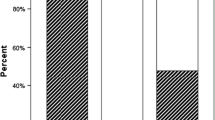Abstract
Two-stage revision is generally preferred to eradicate chronic periprosthetic infections after total hip arthroplasty (THA) because of its good infection control and promising results. During two-stage revision, a temporary antibiotic-impregnated cement spacer was initially used for the local delivery of antibiotics, thereby reducing the risk of infection recurrence. Many researchers have reported various techniques for fabricating cemented spacers; however, there is no established standard technique. We share our cost-effective and easily reproducible technique for creating an articulated cemented spacer for managing infected THA.


Similar content being viewed by others
References
Kim SJ, Cho YJ (2021) Current guideline for diagnosis of periprosthetic joint infection: a review article. Hip Pelvis 33(1):11–17
Wolf M, Clar H, Friesenbichler J, Schwantzer G, Bernhardt G, Gruber G, Glehr M, Leithner A, Sadoghi P (2014) Prosthetic joint infection following total hip replacement: results of one-stage versus two-stage exchange. Int Orthop 38(7):1363–1368
van den Kieboom J, Tirumala V, Box H, Oganesyan R, Klemt C, Kwon Y (2021) One-stage revision is as effective as two-stage revision for chronic culture-negative periprosthetic joint infection after total hip and knee arthroplasty. Bone Joint J 103(3):515–521
Bialecki J, Bucsi L, Fernando N, Foguet P, Guo S, Haddad F, Hansen E, Janvari K, Jones S, Keogh P, McHale S, Molloy R, Mont MA, Morgan-Jones R, Ohlmeier M, Saldaña A, Sodhi N, Toms A, Walker R, Zahar A (2019) Hip and knee section, treatment, one stage exchange: proceedings of international consensus on orthopedic infections. J Arthroplast 34:421–426
Fiore M, Rondinella C, Paolucci A, Morante L, De Paolis M, Sambri A (2023) Functional outcome after reimplantation in patients treated with and without an antibiotic-loaded cement spacers for hip prosthetic joint infections. Hip Pelvis 35(1):32–39
Karachalios T, Koutalos A, Komnos G (2014) Management strategies for infected total hip arthroplasty. a critical appreciation of problems and techniques. HIP Int 24(10):44–47
Chalmers BP, Mabry TM, Abdel MP, Berry DJ, Hanssen AD, Perry KI (2018) Two-stage revision total hip arthroplasty with a specific articulating antibiotic spacer design: reliable periprosthetic joint infection eradication and functional improvement. J Arthroplast 33(12):3746–3753
Corona PS, Barro V, Mendez M, Cáceres E, Flores X (2014) Industrially prefabricated cement spacers: do vancomycin- and gentamicin-impregnated spacers offer any advantage? Clin Orthop Relat Res 472(3):923–932
Erivan R, Lecointe T, Villatte G, Mulliez A, Descamps S, Boisgard S (2018) Complications with cement spacers in 2-stage treatment of periprosthetic joint infection on total hip replacement. Orthop Traumatol Surg Res 104(3):333–339
Magnan B, Regis D, Biscaglia R, Bartolozzi P (2001) Preformed acrylic bone cement spacer loaded with antibiotics: use of two-stage procedure in 10 patients because of infected hips after total replacement. Acta Orthop Scand 72(6):591–594
Funding
No funding was received for conducting this study.
Author information
Authors and Affiliations
Contributions
All authors contributed to the study conception and design. Jun-Ki Moon is the guarantor of submission and participated in study design and data interpretation. Data collection and analysis were performed by Aashay L Kekatpure, Yoon Jae Youn, and Yoon Pil Whan. The first draft of the manuscript was written by Aditya L Kekatpure, and all authors commented on previous versions of the manuscript. All authors read and approved the final manuscript.
Corresponding author
Ethics declarations
Conflict of interest
The authors have no competing interests to declare that are relevant to the content of this article.
Ethical approval
Ethical approval was obtained from the Institutional Review Board of the university hospital prior to conducting this study.
Informed consent
A waiver to obtain written informed consents from the patients was obtained from the Institutional Review Board of the university hospital.
Additional information
Publisher's Note
Springer Nature remains neutral with regard to jurisdictional claims in published maps and institutional affiliations.
Rights and permissions
Springer Nature or its licensor (e.g. a society or other partner) holds exclusive rights to this article under a publishing agreement with the author(s) or other rightsholder(s); author self-archiving of the accepted manuscript version of this article is solely governed by the terms of such publishing agreement and applicable law.
About this article
Cite this article
Kekatpure, A.L., Kekatpure, A.L., Yoon, J.Y. et al. Utilizing an antibiotic-eluting articulated cemented spacer in the two-stage management of infected total hip arthroplasty: a technical note. Eur J Orthop Surg Traumatol (2024). https://doi.org/10.1007/s00590-024-03893-y
Received:
Accepted:
Published:
DOI: https://doi.org/10.1007/s00590-024-03893-y




